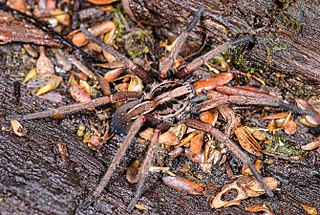
Miturgidae is a family of araneomorph spiders that includes nearly 170 species in 29 genera worldwide. First described by Eugène Simon in 1886, it has been substantially revised, and includes the previous family Zoridae as a synonym, and excludes the family Xenoctenidae. Several genera have also been removed, such as the large genus Cheiracanthium, which was transferred to the Cheiracanthiidae.

Huttoniidae is a family of ecribellate araneomorph spiders containing a single genus, Huttonia, itself containing a single described species, Huttonia palpimanoides. It is known only from New Zealand.

Gradungulidae, also known as large-clawed spiders, is a spider family endemic to Australia and New Zealand. They are medium to large-sized haplogyne spiders with three claws and two pairs of book-lungs similar to Mygalomorphae. Some species build extensive webs with an upper retreat tangle and connecting threads to scaffolding. This supports the ladder-like catching platform that is glued to the ground. Progradungula, a large spider with long legs like Hickmania, and Macrogradungula are the only cribellate genera of the family.

Periegops is a genus of spiders with six eyes instead of the usual eight. It is the only genus in its family (Periegopidae) and has three described species. It was long considered to be a member of Sicariidae or Segestriidae until Raymond Forster elevated it to the family level in 1995.

Orsolobidae is a six-eyed spider family with about 180 described species in thirty genera. It was first described by J. A. L. Cooke in 1965, and was raised to family status from "Dysderidae" in 1985.

Stiphidiidae, also called sheetweb spiders, is a family of araneomorph spiders first described in 1917. Most species are medium size and speckled brown with long legs. All members of this family occur in New Zealand and Australia except for Asmea. They build a horizontal sheet-like web under rocks, hence the name "sheetweb spiders".

Gradungula is a monotypic genus of South Pacific large-clawed spiders containing the single species, Gradungula sorenseni. It is only found in New Zealand.

Spelungula is a monotypic genus of South Pacific large-clawed spiders containing the single species, Spelungula cavernicola, or the Nelson cave spider.

Porrhothele is a genus of mygalomorph spiders endemic to New Zealand. They are the only members of the family Porrhothelidae. They were first described by Eugène Louis Simon in 1892. Originally placed with the curtain web spiders, it was moved to the Hexathelidae in 1980, they were placed in their own family in 2018.

Cantuaria is a genus of South Pacific armored trapdoor spiders that was first described by Henry Roughton Hogg in 1902. From 1985 to 2006 it was merged with former genus Misgolas, now Arbanitis.
Cheiracanthium insulare is a spider species found in Madagascar and Réunion.

Novanapis is a genus of South Pacific araneomorph spiders in the family Anapidae, containing the single species, Novanapis spinipes. It was first described by Norman I. Platnick & Raymond Robert Forster in 1989, and has only been found in New Zealand.

Toxopsiella is a genus of South Pacific araneomorph spiders in the family Cycloctenidae, and was first described by Raymond Robert Forster in 1964.

Kapanga is a genus of South Pacific dwarf sheet spiders that was first described by Raymond Robert Forster in 1970.

Hypodrassodes is a genus of South Pacific ground spiders that was first described by R. de Dalmas in 1919.

Intruda is a monotypic genus of South Pacific ground spiders containing the single species, Intruda signata. It was first described by Raymond Robert Forster in 1979, and has only been found in Australia and in New Zealand.

Nauhea is a monotypic genus of South Pacific ground spiders containing the single species, Nauhea tapa. It was first described by Raymond Robert Forster in 1979, and has only been found in New Zealand.

Zelanda is a genus of South Pacific ground spiders that was first described by H. Özdikmen in 2009.
Subantarctia is a genus of Polynesian araneomorph spiders in the family Orsolobidae, first described by Raymond Robert Forster in 1955.
Matua is a genus of South Pacific ground spiders that was first described by Raymond Robert Forster in 1979. As of May 2019 it contains only two species, both found in New Zealand: M. festiva and M. valida.
















